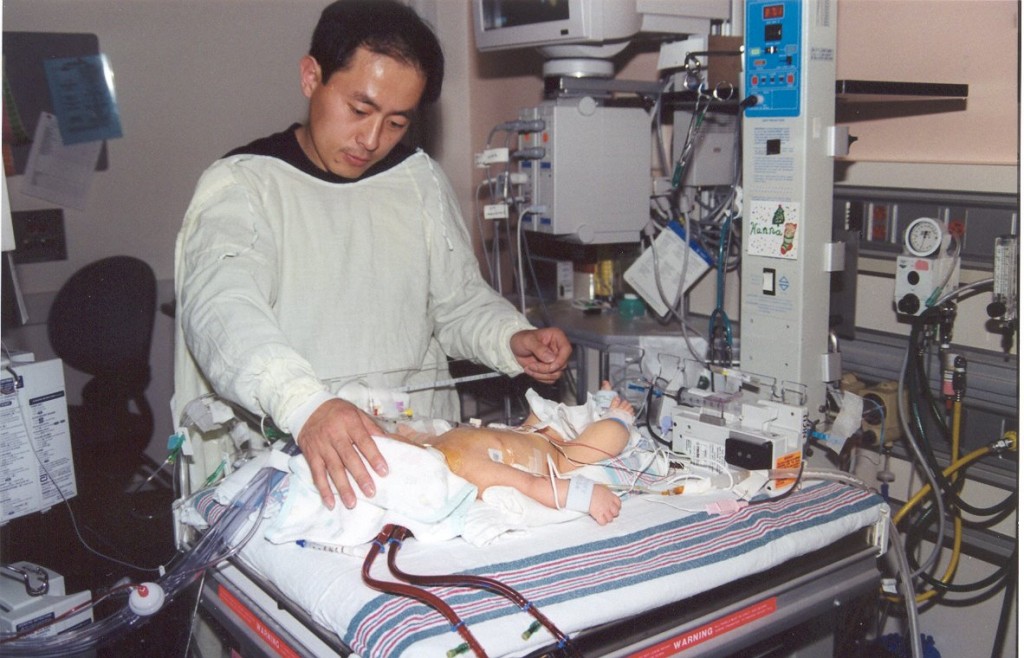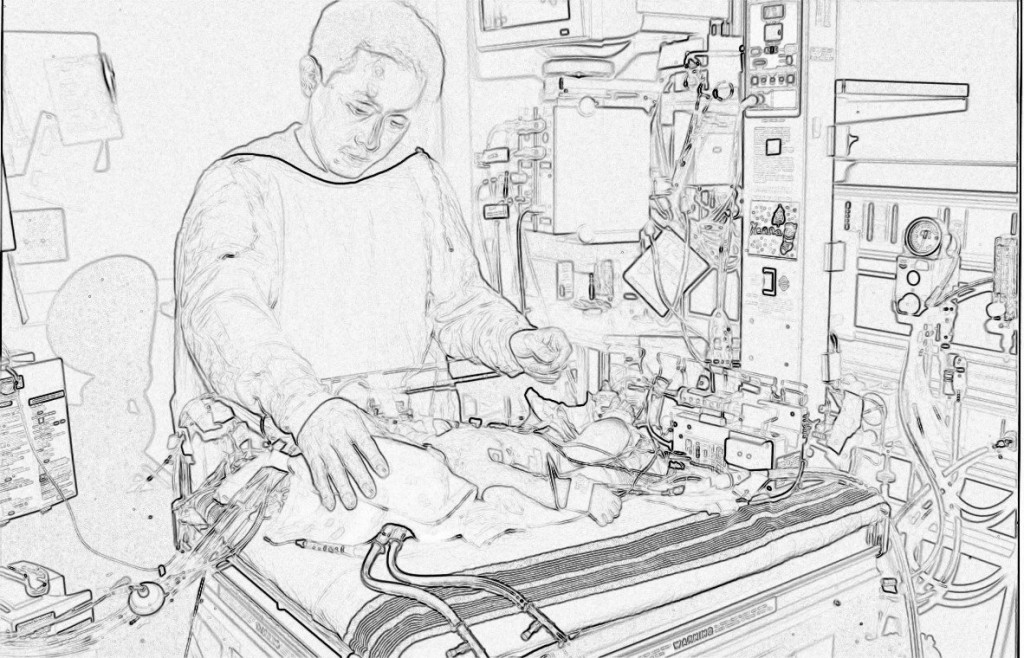1. What is the man in the picture doing?
He is visiting a baby, and he has his hand on the baby’s head.
2. What sort of covering is the man wearing?
He is wearing some scrubs.
3. Why is the man wearing scrubs?
The man is wearing scrubs because the baby has to be in a sterile environment, and be protected from germs.
4. Where is the baby?
The baby is lying on a small baby hospital bed.
5. Why doesn’t the man pick up the baby?
The baby is hooked up to a lot of tubes and various monitors.
6. Why aren’t there other visitors for the baby?
The number of visitors is limited, and only the baby’s parents or close relatives can visit.
7. Is this a regular hospital room?
No, this is a neo-natal intensive care unit (NICU).
8. Is the baby’s condition critical?
Yes, the baby is rather sick.
9. How many tubes are hooked up to the baby?
We see a couple of big tubes coming out near the baby’s head, and there are several other tubes on the baby’s body.
10. What sort of monitors is the baby hooked up to?
The baby is hooked up to a heart rate and blood pressure monitor, as well as monitor that checks the baby’s respiration.
11. How do the monitors help the nurses see how the baby is doing?
The monitors help the nurses by keeping track of the how the baby’s blood pressure, breathing, and heart rate (vital signs) are doing.
12. What would the monitors do if the baby’s blood pressure or heart rate goes too high or too low?
If the baby’s vital signs go too high or too low, the monitors will sound an alarm to alert the nurses that there is a problem, and the baby needs attention.
13. What kinds of information would the nurses write down in the patient’s chart?
In the baby’s chart the nurses would write down the heart rate, blood pressure, respiration, in addition to other information like what kind of medication the baby is being given, and when the last time was that the baby received some medication.
14. What sort of things would the nurses do to take care of the baby?
In addition to watching the baby’s monitors and recording the information, the nurses would give the baby medication, change the IV when necessary, change the baby’s bandages and cleanse the baby’s incisions, or change the baby’s catheter and empty the urine bag.
15. What does a nurse use a stethoscope for?
The nurse uses the stethoscope to listen to the baby’s heart, lungs, and intestines.
16. How does the nurse take the baby’s temperature?
The nurse uses a thermometer to take the baby’s temperature.
17. How would a sick baby like this be fed?
A sick baby like this would probably be fed intravenously, or possibly through a nose tube.
18. How would a sick baby like this be given medicine?
A sick baby like this would be given medicine intravenously.
19. What do the nurses or doctors do if the baby needs extra blood?
If the baby needs extra blood, the doctors or nurses would give the baby a blood transfusion.
20. How long do you think it will be before the baby can go home?
Since the baby is so sick, it will probably be a few weeks before the baby is well enough to go home.
Paragraph: At the Hospital
Write a brief paragraph about the time that you, or a friend or relative, were in the hospital. How was the stay in the hospital? Were the doctors and nurses friendly and helpful?
When our first baby was born, she was very sick because of a condition called meconium aspiration. This happens when the baby has a bowel movement inside the womb and then inhales the fecal matter. This can be a very serious condition, because the meconium coats the lungs and makes it difficult for the baby to get enough oxygen. Our baby needed to be transferred to another hospital where the doctors could operate on her to hook her up to an ECMO (extracorporeal membrane oxygenation) machine to give her lungs a chance to heal and recover. While she was on the ECMO machine, she was in NICU, so we had to wear scrubs to visit her. The visiting hours were limited, and only parents and grandparents could visit, just two at a time. After three or four days, she was able to come off the ECMO machine, but she still needed to be in NICU until her vital signs were healthy. About twelve days after she was born, she was able to come out of NICU and be transferred back to the local hospital, but she still was unable to come home. She had to gain weight and learn how to nurse or feed from a bottle. Eventually, she was healthy enough to be discharged from the hospital, and we took her home on Christmas Eve, over three weeks after she was born.




